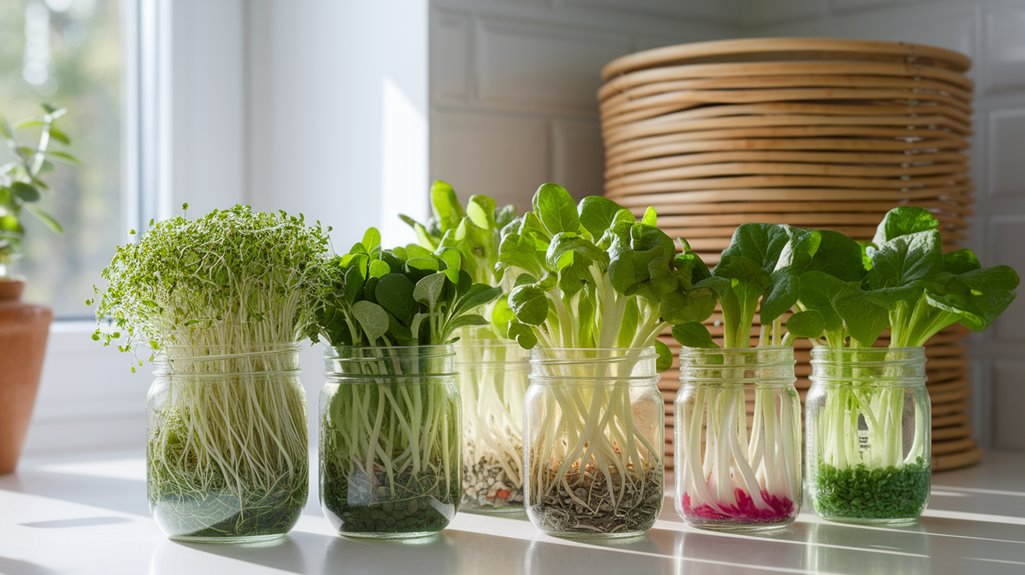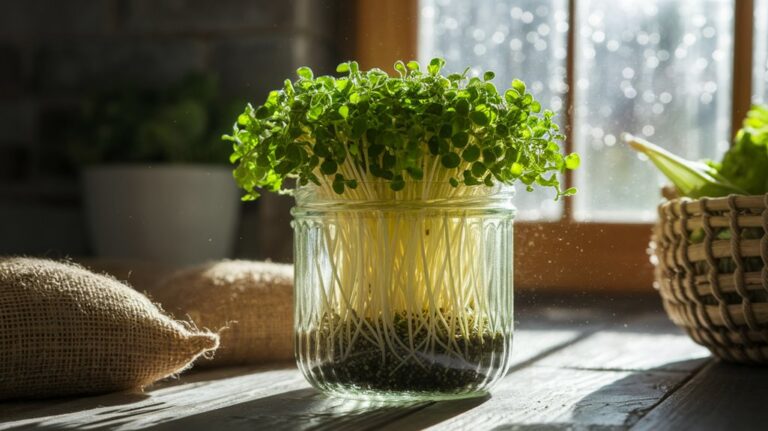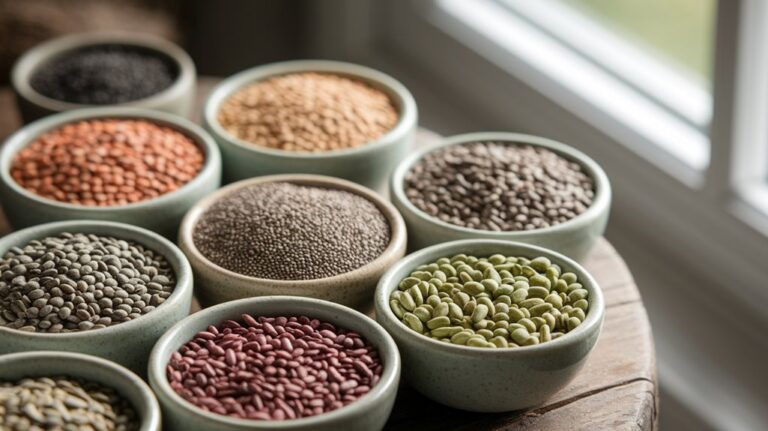Benefits and Ease of Sprouting at Home
Sprouting at home is a simple and cost-effective way to boost your diet with fresh, nutritious greens. I’ve found that it only takes a few days to grow sprouts using minimal equipment. They’re packed with vitamins, minerals, and antioxidants, offering great health benefits like improved digestion and reduced inflammation. Plus, they add unique flavors to meals. If you’re curious about how to get started and the best varieties to try, keep exploring!
Key Takeaways
- Home sprouting is simple, requiring minimal equipment and a few easy steps to grow fresh, nutritious sprouts in just a few days.
- Growing your own sprouts can save up to 50% compared to store-bought options while ensuring freshness and quality.
- Sprouts are nutrient-dense, providing vitamins, minerals, and antioxidants that enhance overall dietary nutrition and support gut health.
- Engaging the whole family in sprouting fosters teamwork, teaches responsibility, and encourages creativity in meal preparation.
- Home sprouting is environmentally friendly, using less water and energy while reducing food waste and transportation emissions.
Nutritional Boost: Enhancing Your Diet With Sprouts
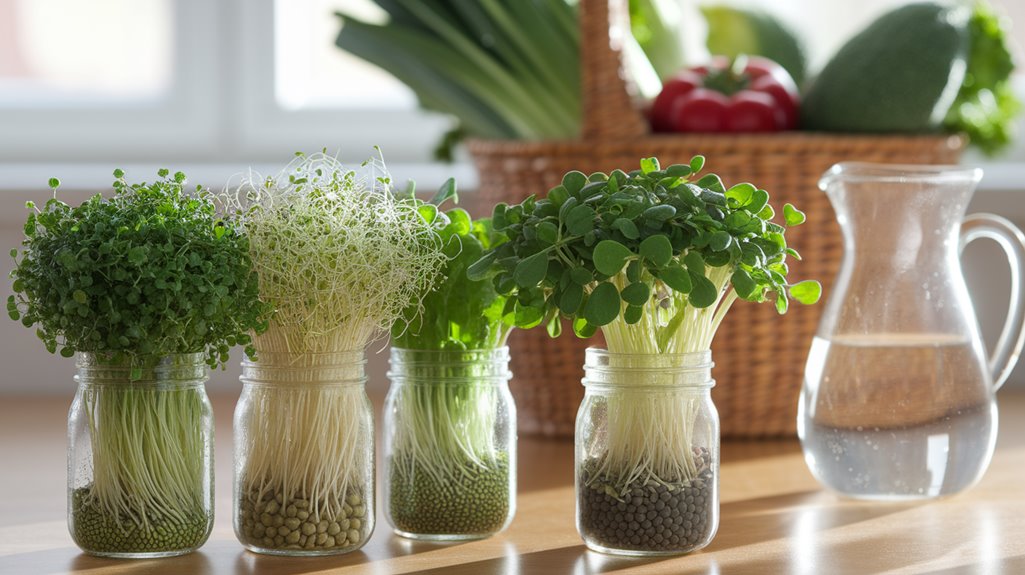
Sprouts are like nature’s little powerhouses, packed with nutrients that can significantly enhance our diets.
I’ve discovered that these tiny greens are loaded with vitamins, minerals, and antioxidants. For instance, broccoli sprouts contain sulforaphane, which has been linked to cancer-fighting properties. They’re also rich in vitamins A, C, and K, promoting overall health.
When I incorporate sprouts into my meals, I not only boost their nutritional value but also add texture and flavor. Plus, they’re low in calories, making them a great choice for anyone looking to maintain a healthy weight.
Easy and Accessible: The Simplicity of Home Sprouting
Sprouting at home is incredibly simple, requiring minimal equipment like a jar and some seeds.
I love how quickly sprouts can grow, often within just a few days, making it a fast way to add nutrients to my meals.
With so many seed options available, I can easily tailor my sprouts to suit my taste and dietary needs.
Minimal Equipment Needed
You only need a few basic items to start sprouting at home, making it an incredibly accessible endeavor for anyone. The simplicity of the process means you won’t be overwhelmed by complicated equipment.
Here’s what I use:
- Seeds: Choose from a variety of options like alfalfa, lentils, or broccoli.
- Jar: A wide-mouth glass jar works perfectly for rinsing and draining.
- Mesh lid: This allows for proper airflow while keeping the seeds contained.
- Water: Clean, filtered water is essential for rinsing and soaking.
With just these items, I’ve found sprouting to be both enjoyable and rewarding.
In no time, you’ll have fresh, nutritious sprouts ready for your meals. It’s that easy!
Quick Growth Cycle
After gathering the minimal equipment, the next exciting aspect of home sprouting is the quick growth cycle.
I’m often amazed at how swiftly seeds transform into nutritious sprouts, usually within just a few days. For example, alfalfa and radish seeds can sprout in as little as three to five days, offering immediate rewards for my efforts.
This rapid turnaround not only satisfies my craving for fresh greens but also allows me to enjoy the health benefits quickly.
The process is straightforward: I soak the seeds, rinse them a couple of times a day, and watch as they come to life.
This efficiency makes home sprouting an accessible option for anyone eager to incorporate fresh, healthy ingredients into their meals without much waiting time.
Versatile Seed Options
While exploring the world of home sprouting, I quickly discovered a variety of seed options that make the process both easy and enjoyable.
Each type offers unique flavors and nutrients, so you’ll never get bored. Here are four versatile seeds I recommend:
- Alfalfa: High in vitamins and minerals, these tiny sprouts add a crunchy texture to salads.
- Mung Beans: Packed with protein, they’re perfect for stir-fries or sandwiches.
- Radish: With a spicy kick, radish sprouts can elevate any dish.
- Broccoli: Known for its cancer-fighting properties, broccoli sprouts are a nutritious addition to your meals.
Cost-Effective: Saving Money With Homegrown Sprouts
Sprouting at home can save you a surprising amount of money—often up to 50% compared to store-bought sprouts. When I realized how much I could save, I was thrilled to ditch the overpriced options. Plus, it’s incredibly easy to grow your own.
Here’s a simple cost comparison I found helpful:
| Item | Store-Bought Price | Homegrown Price |
|---|---|---|
| Alfalfa Sprouts (1 oz) | $3.00 | $1.50 |
| Broccoli Sprouts (1 oz) | $4.00 | $2.00 |
| Mung Bean Sprouts (1 oz) | $2.50 | $1.25 |
With just a few seeds and minimal effort, I’m saving money while enjoying fresh sprouts. It’s a win-win situation that benefits both my wallet and my health!
Fresh Flavors: Adding Variety to Your Meals
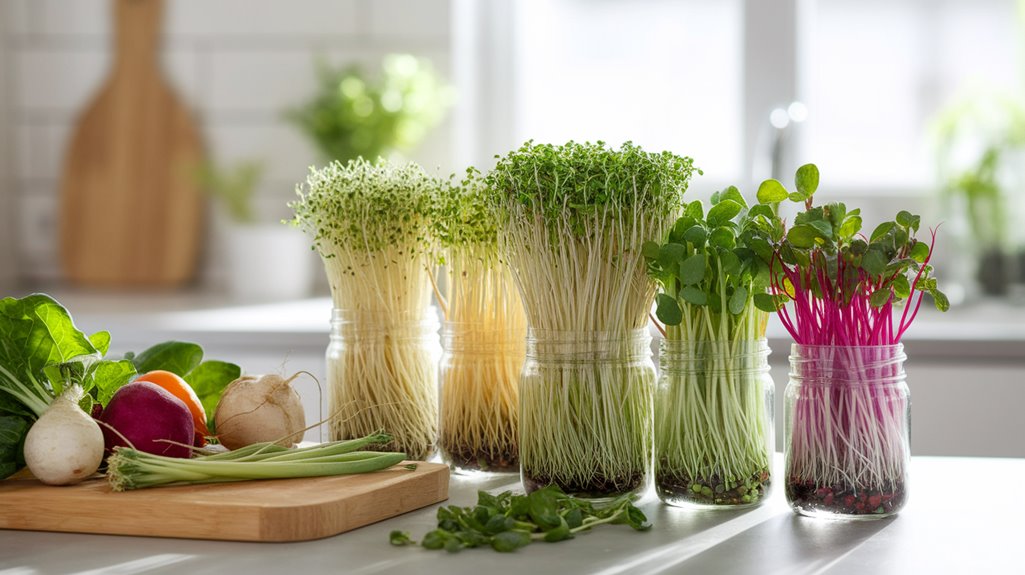
When I add homegrown sprouts to my meals, I’m amazed by the unique taste profiles they bring.
Each type, from radish to pea shoots, offers a different burst of flavor while packing in essential nutrients.
Incorporating these nutrient-dense additions not only enhances my dishes but also boosts my overall health.
Unique Taste Profiles
Many home cooks discover that adding freshly sprouted ingredients can significantly enhance the flavor profiles of their meals.
Sprouts bring unique tastes that elevate dishes in unexpected ways. Here are four distinct flavors I’ve enjoyed:
- Mung Bean Sprouts: They offer a crisp, slightly sweet flavor that’s perfect for stir-fries and salads.
- Radish Sprouts: These add a peppery kick, similar to arugula, which livens up sandwiches and wraps.
- Broccoli Sprouts: With their mild, nutty taste, they’re ideal for topping off soups and grain bowls.
- Alfalfa Sprouts: Their delicate, fresh flavor complements salads and enhances the crunch factor in various dishes.
Incorporating these sprouts not only adds variety but also transforms mundane meals into something extraordinary.
Nutrient-Dense Additions
Incorporating sprouts into my meals hasn’t only enhanced their flavors but also significantly boosted their nutritional value. Sprouts are packed with essential vitamins, minerals, and antioxidants.
For instance, broccoli sprouts contain up to 50 times more sulforaphane, a powerful compound linked to cancer prevention, than mature broccoli. I love tossing alfalfa or radish sprouts into salads and sandwiches for a crunchy texture and a nutrient boost.
Plus, they’re low in calories, making them a perfect addition to any dish without guilt. Whether I’m blending them into smoothies or using them as a garnish, sprouts offer a fresh and vibrant way to diversify my meals while enhancing their health benefits.
Trust me, once you start sprouting, you’ll notice the difference!
Sustainable Living: Reducing Your Environmental Footprint
While I’m passionate about sprouting at home, I also recognize the broader impact our choices have on the environment.
Sprouting not only benefits our health but also supports a sustainable lifestyle. Here are four ways it reduces your environmental footprint:
- Less Waste: Growing sprouts at home minimizes food waste since you can harvest exactly what you need.
- Low Energy Use: Sprouting requires minimal energy compared to traditional farming, lowering your carbon footprint.
- Water Efficiency: Sprouting uses significantly less water than conventional crops, making it a more sustainable choice.
- Local Production: By growing your own sprouts, you cut down on transportation emissions associated with store-bought produce.
Incorporating sprouting into your routine is a simple yet impactful way to live more sustainably.
Versatility in Cooking: Incorporating Sprouts Into Various Dishes
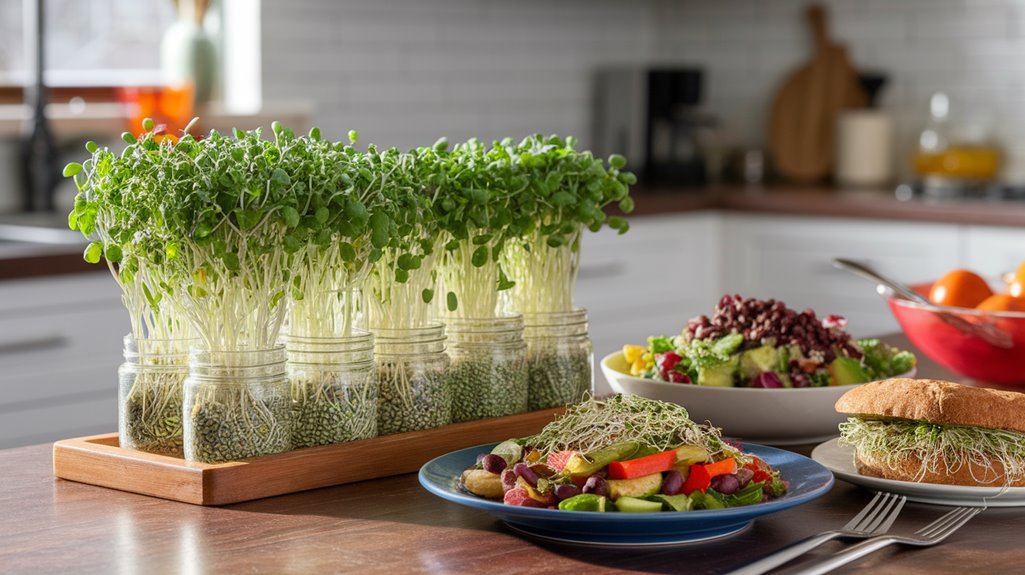
When I discovered the culinary potential of sprouts, I realized how they can elevate a wide range of dishes.
Sprouts are incredibly versatile; I often toss them into salads for a crunchy texture and added nutrients. They also make a fantastic addition to sandwiches, providing a fresh, lively flavor.
When I stir-fry vegetables, I sprinkle in some sprouts at the end for an extra layer of crunch and nutrition. They even work well in smoothies, blending seamlessly and adding a nutritional boost without overpowering the taste.
With their myriad of flavors and textures, sprouts can adapt to nearly any cuisine, making them an easy way to enhance both taste and health in my meals.
Fun for All Ages: Engaging the Whole Family in Sprouting
Sprouting at home isn’t just a fun culinary adventure; it’s also a fantastic way to involve the whole family. I’ve found that engaging everyone in sprouting fosters teamwork and learning.
Here are some practical ways to get everyone involved:
- Choose Your Sprouts: Let each family member select their favorite seeds to sprout. This builds excitement and ownership.
- Set Up a Sprouting Station: Create a dedicated space for sprouting. Involving kids in the setup teaches them about organization.
- Daily Care: Assign everyone tasks—rinsing, draining, and observing growth. This instills responsibility and patience.
- Taste Testing: Once the sprouts are ready, have a family tasting session. Celebrating the results makes the effort rewarding.
Health Benefits: Supporting Digestive Health and More
Incorporating sprouts into your diet can significantly enhance your digestive health, as they are rich in enzymes and nutrients that facilitate digestion. Sprouts contain fiber, which promotes regularity and supports gut health. They also help balance gut bacteria, making them an excellent choice for overall wellness.
Here’s a quick look at some key benefits of including sprouts in your meals:
| Type of Sprout | Nutrient Benefits | Digestive Support |
|---|---|---|
| Alfalfa | Vitamins A, C, K | Aids in digestion |
| Mung Bean | Protein, Fiber | Promotes gut health |
| Broccoli | Antioxidants | Fights inflammation |
| Lentil | Folate, Iron | Enhances nutrient absorption |
Adding these tiny powerhouses to your diet can truly make a big difference!
Quick and Convenient: Sprouting in Just a Few Days
Adding sprouts to my diet not only boosts my digestive health but also offers a quick and convenient way to enhance my meals.
Within just a few days, I can enjoy fresh, nutritious sprouts right from my kitchen. Here’s how I make it work:
- Choose your seeds: I love using alfalfa, broccoli, or mung beans.
- Soak: I soak the seeds in water for 4-8 hours, kickstarting the germination process.
- Rinse and drain: I rinse the seeds every 8-12 hours to keep them moist and prevent mold.
- Harvest: In about 3-5 days, I’ve got delicious sprouts ready to toss into salads, sandwiches, or smoothies.
It’s that simple, and the nutritional payoff is well worth the effort!
Frequently Asked Questions
Conclusion
In conclusion, sprouting at home offers numerous benefits, from boosting nutrition to enhancing flavor in your meals. It’s incredibly easy and cost-effective, making it accessible for everyone. Plus, engaging in this fun activity can bring the family together while promoting sustainable living. With just a few days of patience, you can enjoy fresh, nutritious sprouts that support your health and elevate your cooking. So why not give it a try and reap the rewards of home sprouting?

